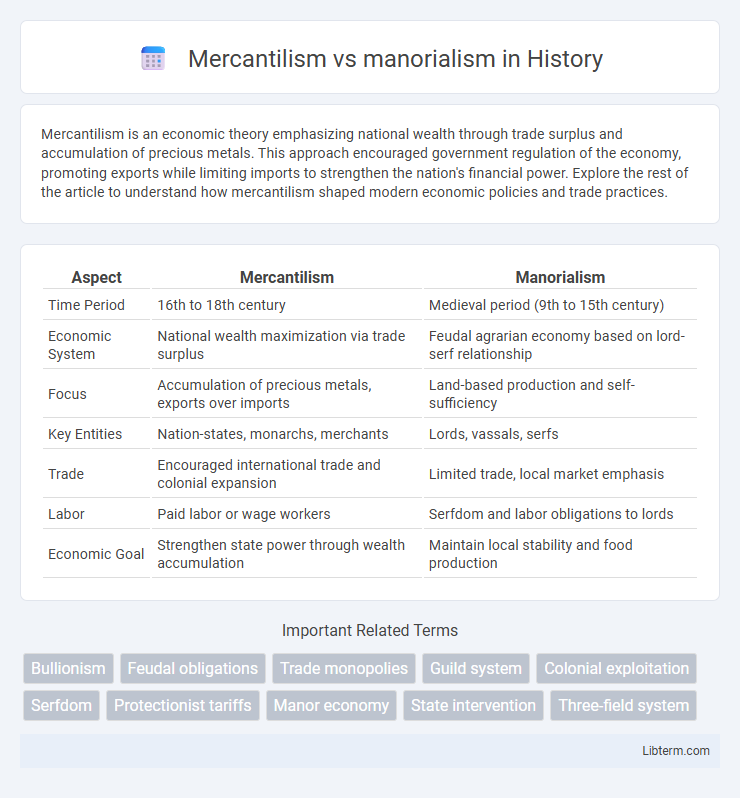Mercantilism is an economic theory emphasizing national wealth through trade surplus and accumulation of precious metals. This approach encouraged government regulation of the economy, promoting exports while limiting imports to strengthen the nation's financial power. Explore the rest of the article to understand how mercantilism shaped modern economic policies and trade practices.
Table of Comparison
| Aspect | Mercantilism | Manorialism |
|---|---|---|
| Time Period | 16th to 18th century | Medieval period (9th to 15th century) |
| Economic System | National wealth maximization via trade surplus | Feudal agrarian economy based on lord-serf relationship |
| Focus | Accumulation of precious metals, exports over imports | Land-based production and self-sufficiency |
| Key Entities | Nation-states, monarchs, merchants | Lords, vassals, serfs |
| Trade | Encouraged international trade and colonial expansion | Limited trade, local market emphasis |
| Labor | Paid labor or wage workers | Serfdom and labor obligations to lords |
| Economic Goal | Strengthen state power through wealth accumulation | Maintain local stability and food production |
Introduction to Mercantilism and Manorialism
Mercantilism emerged in the 16th century as an economic theory emphasizing state control over trade and accumulation of precious metals to increase national wealth. Manorialism, dominant in medieval Europe, was a socio-economic system where peasants worked land owned by lords in exchange for protection and a portion of the harvest. Both systems structured economic activity but differed fundamentally, with mercantilism focusing on national economic policy and trade, while manorialism centered on localized agricultural production and social hierarchy.
Origins and Historical Context
Mercantilism originated in Europe during the 16th to 18th centuries, emerging as a response to the rise of nation-states and global trade expansion, emphasizing state control over economic resources and accumulation of wealth through a positive balance of trade. Manorialism developed earlier in the medieval period between the 9th and 15th centuries, rooted in the feudal system where agrarian estates, or manors, functioned as self-sufficient units structured around serfdom and localized agriculture. These economic systems reflect distinct historical contexts: mercantilism aligns with early modern capitalism and colonialism, while manorialism represents the agrarian-based, localized economy of feudal Europe.
Core Principles of Mercantilism
Mercantilism centers on the accumulation of wealth through a positive balance of trade, emphasizing state control over the economy to maximize exports and minimize imports. It advocates for strong government intervention, including tariffs, monopolies, and colonial expansion, to enhance national power and economic self-sufficiency. Unlike manorialism, which is based on localized feudal estates and agricultural production, mercantilism focuses on national economic growth driven by commerce and resource accumulation.
Fundamental Features of Manorialism
Manorialism, the dominant economic system of medieval Europe, revolved around the manor, a self-sufficient estate controlled by a lord who granted land to peasants in exchange for labor and produce. Its fundamental features included the lord's judicial authority, serfs bound to the land, and a reciprocal relationship where peasants owed labor services or rents while receiving protection and access to communal resources. Unlike Mercantilism's focus on trade and state-controlled wealth, Manorialism emphasized local agricultural production and hierarchical social obligations within rural communities.
Economic Structures Compared
Mercantilism is characterized by a centralized economic structure emphasizing state-controlled trade, accumulation of wealth through exports, and the establishment of colonies to enhance national power. Manorialism operates as a decentralized economic system centered on self-sufficient estates where lords wielded control over land and serfs who provided labor in exchange for protection. The key distinction lies in mercantilism's focus on expanding national economies via international commerce versus manorialism's localized, agrarian-based economy structured around feudal obligations.
Social Hierarchies and Class Relations
Mercantilism reinforced social hierarchies through the rise of a wealthy merchant class that capitalized on trade and colonial expansion, often influencing political power and wealth distribution in urban centers. Manorialism maintained rigid class relations within rural feudal estates, where serfs and peasants were bound to the land under the authority of local lords, reflecting a predominantly agrarian social structure. The shift from manorialism to mercantilism marked a transition from land-based feudal power to capital-driven economic and social stratification.
Role of Trade and Markets
Mercantilism emphasizes the expansion of national wealth through state-controlled trade, promoting exports over imports to accumulate precious metals and maintain a favorable balance of trade. Manorialism operates within a localized agrarian economy where trade and markets play a minimal role, primarily serving self-sufficient estates with limited external exchange. The shift from manorialism to mercantilism reflects a transition from localized subsistence to a structured market economy driven by international commerce and government regulation.
Impact on Rural and Urban Life
Mercantilism spurred urban growth by promoting trade, commerce, and the rise of merchant classes, which led to increased wealth and economic opportunities in cities. Manorialism maintained rural life through feudal landholding systems, where peasants worked the land under lords, limiting social mobility and economic diversification in the countryside. The shift from manorialism to mercantilism marked a transition from agrarian-based economies to market-driven urban centers, reshaping social structures and livelihoods.
Decline and Legacy of Both Systems
Mercantilism declined as industrial capitalism and free trade theories emerged in the 18th century, challenging its protectionist policies and state control over economies. Manorialism waned with the rise of centralized monarchies and the shift towards market-based agriculture during the late medieval and early modern periods. Both systems left legacies shaping modern economic structures: mercantilism influenced colonial expansion and trade regulations, while manorialism laid the groundwork for feudal social hierarchies and rural economic organization.
Mercantilism vs Manorialism: Key Differences and Lasting Influence
Mercantilism centers on national economic growth through trade surplus and accumulation of precious metals, contrasting with manorialism's feudal system focused on self-sufficient agrarian estates managed by lords and peasants. Key differences include mercantilism's promotion of centralized government regulation and global commerce versus manorialism's localized, agrarian-based economy with hierarchical land tenure. Mercantilism's lasting influence shaped modern capitalism and global trade networks, while manorialism's decline marked the transition from medieval feudalism to early modern economic systems.
Mercantilism Infographic

 libterm.com
libterm.com